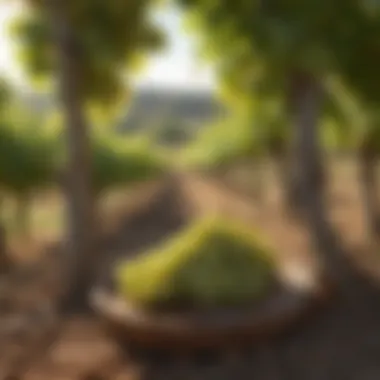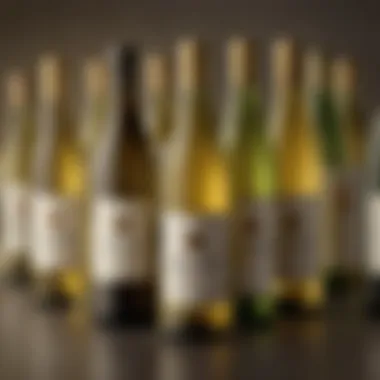Discovering the Finest Crisp Chardonnay Wines


Intro
Crisp Chardonnay—these two words bring to mind a lightweight yet flavorful experience, elegant yet powerful in its expression. Most wine enthusiasts and casual drinkers alike have savored a glass or two, but few truly grasp the intricacies of what makes a Chardonnay "crisp". Understanding the unique traits of this beloved varietal stretches beyond mere flavors, venturing into the soil of the regions where it's grown, the climate it thrives in, and the meticulous processes winemakers use.
In this guide, we explore the essence of the best crisp Chardonnays. With an emphasis on the stunning terroirs like Burgundy and California, we will dissect flavor profiles that range from zesty citrus to rich buttery notes. Further, we’ll dive into how specific food pairings can elevate your tasting experience, turning mere sipping into an artful endeavor. And, of course, we won't skip over the esteemed labels that have etched their names into the annals of wine history, paving the way for what a high-quality Chardonnay should entail.
As you embark on this journey, you’ll discover that a great crisp Chardonnay is much like a favorite story—layered, intricate, and always leaving you longing for the next chapter. So, pour yourself a glass, settle in, and let's take an enlightening stroll through the world of Chardonnays.
Preamble to Chardonnay
The world of wine is brimming with different varietals, but Chardonnay sits elegantly at the forefront. This variety's versatility makes it a staple choice for both casual drinkers and seasoned connoisseurs alike. Understanding Chardonnay isn’t just about knowing its taste; it’s about appreciating its history, the climates where it thrives, and its myriad flavors. In this article, we will explore what makes Crisp Chardonnay so special. We will look at its defining characteristics, the best regions for its production, and how different factors can shape its exceptional flavor profiles.
A Brief Overview of Chardonnay
Chardonnay is one of the most popular wine grapes worldwide. Originating from the Burgundy region in France, it has evolved into a global phenomenon, found in vineyards across numerous continents. The wine produced from this grape can range significantly in flavor, texture, and aroma, depending on the region, climate, and vinification methods used.
While it can be oaked or un-oaked, Crisp Chardonnay is often celebrated for its refreshing qualities, light body, and vibrant acidity. These characteristics make it perfect for those warm summer evenings, paired with dishes like grilled fish or fresh salads. The grape has the unique ability to express the terroir where it is grown, translating the specific nature of the soil and climate into each sip.
Historical Significance
The allure of Chardonnay is deeply rooted in its storied history. This grape traces back to at least the 12th century in Burgundy. Established monasteries played a pivotal role in cultivating this vine, and it became revered for its quality. As the centuries rolled by, Chardonnay found its way into various regions.
In the 20th century, the grape gained immense popularity in the United States, especially California. Its adaptability allowed winemakers to experiment freely. Vintners began to refine their processes, focusing on producing wines with crispness and complexity. As a result, Chardonnay underwent a transformation—no longer just a French staple but an international phenomenon.
"Chardonnay is the wine that truly represents the diversity of terroir—each bottle tells its own tale of place and time."
Today, with climates shifting and new techniques emerging, Crisp Chardonnay continues to evolve while retaining its esteemed place in the hearts of wine lovers everywhere. As we delve further into this guide, prepare to explore the world of Crisp Chardonnay: its defining traits, ripe regions, food pairings, and those extraordinary labels that every enthusiast should know.
Characteristics of Crisp Chardonnay
Understanding the characteristics of crisp Chardonnay is key to appreciating this grape variety. Crispness is not merely a flavor descriptor; it speaks volumes about the wine’s freshness and vibrancy. Crisp Chardonnay often serves as a refreshing palate cleanser, making it an excellent companion for many dishes. When one speaks of crisp Chardonnay, it's essential to explore three main attributes: the defining crispness, the tasting notes that emerge, and how different elements mold these flavors.
Defining Crispness
Crispness in wine is a delightful balance that can truly elevate the drinking experience. It refers to a certain sharpness or brightness in flavor, often linked to acidity levels. In crisp Chardonnays, this acidity is usually high, giving the wine a zesty character that dances on the palate. Such wines are often appreciated because they feel refreshing, much like a cool breeze on a hot day. This brisk acidity not only enhances the flavor of the wine but also contributes to its longevity. Wines that exhibit this crisp profile can age gracefully, with their acidity helping to preserve the wine’s freshness over time.
Tasting Notes
Diving deeper into the tasting notes, we uncover layers of complexity that make crisp Chardonnay a favorite among many wine enthusiasts.
Fruitful Aromas
Fruitful aromas play a significant role in the appeal of crisp Chardonnay. Think of citrus—grapefruit, lemon, and lime are often the first to come to mind. They provide an enticing first impression even before tasting. The presence of these vibrant fruit notes adds not just elements of fragrance but also hints of sweetness that can balance the wine's acidity. A notable characteristic of fruitful aromas is how they can transport the taster to sunny vineyards. This evokes an image of warm weather and fresh produce, making Chardonnay not merely a wine, but an experience.
Moreover, these aromas vary significantly by region, influenced by where the grapes are grown. For instance, Chardonnays from California might showcase a ripeness and tropical notes absent in cooler climate versions, such as those from Burgundy. This variation makes fruitful aromas particularly essential for those looking to explore the diversity of Chardonnays on the market.
Acidity and Balance
Acidity is a double-edged sword; when in harmony with other flavors, it enhances the overall drinking experience. A high-acid Chardonnay strikes a fine balance, where the tartness does not overpower other elements but rather complements them. This key characteristic of acidity often makes it a perfect pairing for rich foods, like creamy pastas or seafood, where it helps cut through the fat, creating a well-rounded meal.
The unique feature of acid in crisp Chardonnays aids not only in flavor balance but also in perceived freshness. That invigorating sensation, much like biting into a fresh apple, leaves a crisp finish that lingers. Moreover, the balance achieved through acidity is crucial for establishing a complexity that can make each sip more interesting than the last.
Minerality Influence
Minerality is another integral aspect of many crisp Chardonnays. This characteristic is often described as a chalky or flinty quality that can impart a sense of place to the wine. When talking about minerals, one often thinks of the soil in which the grapes are grown. Regions like Burgundy, known for their limestone-rich soil, produce wines with a distinct mineral backbone that can be perceived on the palate.


The influence of minerality provides an additional dimension, bridging the earthy components with the fruit and acidity. This characteristic is often a reason why sommeliers and wine lovers rave about the layers in a great Chardonnay. The challenge, however, lies in balancing these mineral notes with other flavors—too much can overshadow the fruitiness, making the wine feel austere. It’s this careful blend of all flavours that contributes to the dynamic nature of crisp Chardonnay.
"The essence of crisp Chardonnay lies in its bright acidity, fragrant fruit, and distinctive minerality, all intertwined to create an experience unlike any other."
In understanding the characteristics of crisp Chardonnay, one sees that it is not just a beverage but an intricate tapestry woven from various elements – acidity, fruitful aromas, and mineral notes. Each component adds its unique flair, making crisp Chardonnay a nuanced choice on the wine spectrum.
Wine Regions Renowned for Crisp Chardonnay
Understanding the wine regions that excel in producing crisp Chardonnay is crucial for anyone looking to deepen their appreciation for this vibrant varietal. Each region brings its own unique terroir, a term that encompasses the geology, climate, and even cultural aspects of wine production. The specific elements of soil composition, climate, and vinification techniques work together to shape the final product.
These factors don’t just influence flavor; they also determine the wine's character, usability, and even its compatibility with food. Thus, knowing where to find the best Chardonnays can dramatically elevate one’s tasting experience and enrich pairing opportunities.
California's Coastal Vineyards
California boasts diverse geographical features that contribute to its reputation as a premier Chardonnay producer. The coastal vineyards, in particular, benefit from the cooling influence of the Pacific Ocean. Regions like Sonoma and Santa Barbara deliver crisp Chardonnays that are full of life and vivacity. The morning fog and cool ocean breezes create a microclimate that preserves acidity while allowing the grapes to develop rich, fruity flavors.
The result? Chardonnays from these areas typically present vibrant notes of green apple and citrus, often underlined by a zesty minerality. Additionally, the innovative vinification methods employed by Californian winemakers—think barrel fermentation and the careful selection of yeast strains—enhance the tasting profile even further.
Highlights of California Coastal Chardonnays:
- Key Flavor Notes: Green apple, lemon zest, and hints of tropical fruits
- Acidity & Balance: Crisp acidity retaining freshness
- Vinification Style: A mix of oak aging and stainless steel to contribute depth
The Burgundy Region in France
France's Burgundy region stands as the historic heartland of Chardonnay production. The Chablis subregion, in particular, is famous for its light-bodied, purely crisp Chardonnay. This area benefits from unique Kimmeridgian soil—rich in limestone and clay—that imparts a signature flintiness to the wines.
In Burgundy, the art of winemaking has been meticulously honed over generations. Here, the focus is on creating wines that reflect the true character of the grapes rather than overshadowing them with excessive oak influence. The Chardonnays often communicate delicate floral aromas, coupled with notes of green apple and subtle spices. This region excels in crafting wines that display both elegance and complexity.
Key Attributes of Burgundy Chardonnays:
- Flavor Complexity: Citrus, white flowers, and mineral undertones
- Aging Potential: Many can be cellared for years, evolving beautifully with time
- Vinification: Traditional methods enhancing terroir expression
Australia’s Cool Climate Areas
Australia is gaining recognition for its crisp Chardonnay, especially from its cool-climate regions like Adelaide Hills and Tasmania. These areas experience longer ripening seasons, allowing grapes to develop flavors more slowly while retaining essential acidity. As a result, the Chardonnays produced here are noted for their elegant profiles and refined balance.
The unique Australian take on Chardonnay often includes a character of stone fruits—think peach and nectarine—often layered with a touch of oak. This combination creates a rich yet refreshing drinking experience, with many winemakers focusing on minimal intervention to showcase the natural essence of the grape.
Essential Qualities of Australian Cool-Climate Chardonnays:
- Aromatic Profile: Peach, apricot, and hints of vanilla
- Freshness: Bright acidity retains crispness
- Innovative Approach: Winemakers often prefer minimal intervention, allowing for an authentic fruit expression
Exploring the best Chardonnay involves more than just choosing a label; understanding the regions and their specific contributions can elevate your enjoyment infinitely.
Factors Influencing the Flavor Profile
Understanding how different elements affect the flavor profile of crisp Chardonnay is essential for those looking to appreciate its full complexity. Each bottle tells a story shaped by its environment and vinification choices. Factors such as soil composition, climate conditions, and winemaking techniques contribute significantly. This knowledge empowers wine enthusiasts to select a Chardonnay that aligns with their personal taste and enhances culinary experiences.
Soil Composition
Soil composition plays a crucial role in vineyards. Chardonnay thrives in various types of soils, each imparting distinct attributes to the wine.
- Limestone: Found in regions like Burgundy, it contributes to the minerality, giving the wine a sharp edge. The natural drainage of limestone helps in producing fruit-forward flavors without excess water.
- Clay: This type retains moisture, aiding in grape maturation. Chardonnays from clay-rich soils often showcase depth and creaminess, with a richer texture.
- Sand: Found in regions like California’s coastal vineyards, sandy soils ensure good drainage but can lead to lighter wines with vibrant acidity.
By understanding these soil types, aficionados can better predict the flavor nuances in each sip of Chardonnay.


Climate and Weather Patterns
Climate is another pivotal factor influencing Chardonnay's flavor. The climate dictates the ripeness of grapes, which in turn shapes the wine's character.
- Cool Climate: Regions like Chablis in France produce crisp, high-acid wines due to cooler temperatures. This essence offers a refreshing quality, often packed with citrus and green apple notes.
- Warm Climate: In California, for instance, warmer conditions yield riper grapes, leading to Chardonnays with stone fruit qualities like peach and apricot. These wines tend to be fuller-bodied and more opulent.
- Microclimates: Small changes in geography can create unique flavors, as seen in California's Napa Valley. Here, one vineyard might produce a buttery Chardonnay, while just a few miles away, another vineyard could deliver a crisper version.
The interaction between climate and the vineyards defines the personality of each wine.
Vinification Techniques
Vinification techniques are where science meets artistry in winemaking. The choices made during this process are crucial in crafting the final product.
Fermentation Process
Fermentation significantly influences Chardonnay’s flavor profile. Typically, this process converts the sugars in the grape juice into alcohol, but it's more nuanced than that.
- Temperature Control: Cooler fermentation temperatures help preserve the grapes' fresh fruit characteristics, while warmer fermentation can enhance body and richness. It's a balancing act that winemakers must manage carefully.
- Wild Fermentation: Some producers opt for spontaneous fermentation using natural yeasts, leading to complex flavors and added depth.
The fermentation process is a key characteristic of Chardonnay that reflects the winemaker’s style. A well-managed fermentation can encourage elegant flavors and enhance the crispness of the wine.
Oak Aging vs. Stainless Steel
The aging process also lastingly affects Chardonnay’s profile. Winemakers often debate the merits of oak aging versus stainless steel.
- Oak Aging: This technique introduces notes of vanilla, spice, and toast, contributing to a creamier mouthfeel. While it can add complexity, too much oak can overshadow the wine’s inherent fruitiness, potentially leading to an unbalanced flavor.
- Stainless Steel: In contrast, aging in stainless steel preserves the chardonnay’s clean fruit character and crisp acidity. Consequently, the wine retains its freshness, making it a popular choice for those searching for a light, refreshing experience.
Both methods bring unique textures and flavors, capturing the diverse expressions of Chardonnay exquisitely.
Food Pairing Recommendations
When it comes to enjoying Chardonnay, especially the crisp varieties, food pairings play a crucial role in enhancing the tasting experience. Finding the right match not only accentuates the flavors in the wine, but also enriches the dining occasion, creating a harmonious intermingling of textures and tastes. This section dives into some recommendations that can elevate your appreciation of crisp Chardonnay, making your mealtime a delightful adventure.
Seafood and Chardonnay
Seafood is often hailed as a classic companion to Chardonnay. The lively acidity and fruity notes in crisp Chardonnay cut through the rich flavors found in various seafood dishes. Think about a lovely plate of grilled salmon or shrimp tacos. The citrusy hints in the wine complement the natural sweetness of the seafood, creating a match made in culinary heaven.
A few specific pairings to consider:
- Grilled fish with a lemon butter sauce: The zest enhances the wine’s refreshing qualities.
- Oysters on the half shell: Here, you find a briny taste that works well with a chilled Chardonnay, highlighting both the wine and the oysters' inherent sweetness.
- Tuna Tartare: The smooth texture of the fish blended with the wine's crispness provides a balanced mouthfeel.
"The true essence of pairing Chardonnay with seafood lies in how the distinct oceanic flavors and the wine's refreshing qualities mingle with one another, painting a picture of a sun-soaked seaside meal."
Poultry Dishes
Chardonnay is also a fantastic companion for poultry dishes. When roasted or grilled, chicken, turkey and duck can bring out the complexity of a crisp Chardonnay. The wine’s acidity works to complement the textures and flavors of white meats, making for a well-rounded pairing.
Consider these options:
- Roast chicken with herbs: The earthiness of the herbs highlights the wine's fruitiness.
- Grilled chicken Caesar salad: The crisp freshness of the salad and the wine create an invigorating palate.
- Duck confit: The richness of duck finds a balance with the wine’s bright notes, making for an intricate flavor experience.
Vegetarian Options
While many might think of meat-centric dishes, vegetarian options can also create delightful pairings with crisp Chardonnay. Salads, vegetable preparations, and pasta dishes can showcase the wine's acidity and minerality.
Try embracing the following:


- A fresh spinach and goat cheese salad: The tanginess of the cheese pairs excellently with the wine, bringing out a light and refreshing combination.
- Pasta primavera: The blend of seasonal vegetables, when sautéed lightly, brings a delightful crunch that complements the wine's crisp profile.
- Mushroom risotto: The earthiness of mushrooms paired with Chardonnay offers richness that accentuates the wine's complexities rather than overwhelming them.
By exploring these pairings, you can discover how each element works together to offer a unique tasting narrative, encouraging the already delightful crisp Chardonnay to shine brightly at your table.
Recognized Labels of Crisp Chardonnay
When it comes to enjoying crisp Chardonnay, the labels we choose can make all the difference. Recognized wineries not only have established a reputation for quality but also embody the intricate relationship between terroir and winemaking techniques. Choosing a bottle from an esteemed label is like holding a piece of the vineyard that reflects the nuances of its environment and the skill of its makers. This section will unravel some of the most noteworthy producers of crisp Chardonnay, providing insights that can enhance the wine experience for enthusiasts and casual drinkers alike.
Top French Chardonnays
France stands as the birthplace of Chardonnay, and its vineyards are home to some of the world's most acclaimed labels. In the Burgundy region, for instance, Domaine de la Vougeraie crafts Chardonnays that speak volumes about the soil and climate. This vineyard's meticulous practices allow them to produce whites that showcase an incredible range from fresh citrus to buttery richness. Another notable producer is Louis Jadot, famous for its beautiful expression of Arbois. Their attention to finer details in the vineyard and cellar culminates in crisp, aromatic whites that are simply enchanting.
A few renowned labels worth looking out for:
- Bouchard Père et Fils
- Domaine Lafon
- Coche-Dury
These labels not only represent the pinnacle of French Chardonnay but also provide a window into the rich history and tradition behind the wine.
Award-Winning Californian Producers
Across the pond, California has carved out a reputation as a powerhouse for crisp Chardonnays. The Kistler Vineyards is often recognized for producing some of the finest examples of this varietal. Their Chardonnay takes on a flinty minerality that perfectly meshes with vibrant fruit flavors. Similarly, Far Niente is worth mentioning for its commitment to crafting exceptional Chardonnays that reflect the sunny, diverse climates of Napa Valley. Their offerings are renowned for their balance and elegance, charming palates everywhere.
Some other noteworthy Californian labels include:
- Rombauer Vineyards
- Stag’s Leap Wine Cellars
- Chateau Montelena
These producers have set high standards in the industry, earning accolades and awards that validate their dedication to quality.
Notable Australian Creators
Australia, particularly in areas like Margaret River and Adelaide Hills, has emerged as a formidable player in the world of crisp Chardonnay. Labels like Leeuwin Estate have utilized their maritime climate to create Chardonnays that are vibrant and robust. The fusion of tropical fruit flavors with a crisp backbone makes this a standout choice. Meanwhile, Pathway winery is another gem that embraces the cool climates to yield Chardonnays showcasing intense minerality and refreshing acidity, making every sip a delightful experience.
Prominent Australian labels to keep in mind include:
- Penfolds
- Yalumba
- D'Arenberg
Each of these producers not only reflects their region's character but has also earned recognition in international circles for their innovative approaches to Chardonnay winemaking.
"The world of crisp Chardonnay is not just about the wine itself, but the stories, the people, and the land behind every label."
The End
In bringing together the immense variety of factors that influence crisp Chardonnay, this article sheds light not merely on a drink, but on an experience. The conclusion serves as a critical checkpoint, synthesizing the information delved into. From the discussions on the grapes’ distinctive aromas to the soil’s mineral content, we’ve explored how each element plays its part in crafting that perfect pour.
Summarizing the Journey through Chardonnay
As we weave through the nuances of crisp Chardonnay, it’s vital to appreciate the complexity that lies beneath the surface. The journey traverses various regions, each imbuing their Chardonnays with a unique signature. California’s coastal vineyards often conjure images of bright citrus and crisp apples, while Burgundy brings forth a different melody—one of elegance, showcasing minerality and a balancing act of rich flavors and acidity.
With each sip, we engage in a dance of flavors, where fruitful aromas blend seamlessly with an uplifting acidity. The minerality found in some wines hints at the earth they grew from, while the vinification practices—like the choice between oak aging or stainless steel—further sculpt the taste and mouthfeel of these wines.
This journey does more than delineate flavors. It compels a realization, an awakening of sorts: that understanding these wines is an invitation to find joy in exploration. That "aha moment" when you discover your perfect Chardonnay is a thrill worth seeking.
Encouraging Exploration Beyond the Bottle
So where do we go from here? Beyond the bottle of crisp Chardonnay lies a vast world of flavors waiting to be uncovered. Each wine is a message, a story carried over age and gravity, connecting us not just to the producers, but to the regions that continuously nurture these grapes. I encourage you to engage with these wines, but also to connect with the narratives behind them.
When selecting a Chardonnay, perhaps branch out beyond the familiar labels. Don’t shy away from trying wines from lesser-known producers or different regions altogether. Engage in blind tastings with friends and family; it could open your eyes to unexpected favorites.
Sharing experiences at wine tastings or winery visits also fosters an understanding that goes beyond mere enjoyment. It’s about the interactions, the stories shared, and the richness of friendships cultivated over clinking glasses. After all, wine is best enjoyed in good company.
Ultimately, the exploration of crisp Chardonnay transcends mere tasting. It invites you to weave your own narrative into the rich tapestry of the wine world, urging growth and discovery. Embrace this journey—every bottle holds a promise of delight, waiting to be realized.







